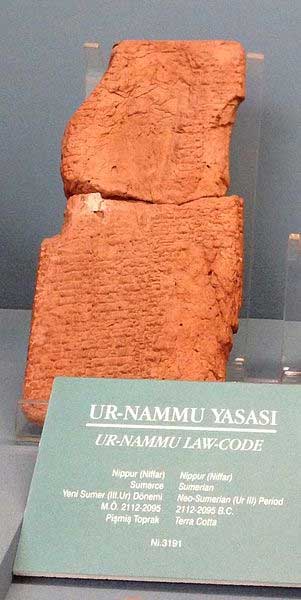The Code of Ur-Nammu: When Ancient Sumerians Laid Down the Law, Everyone Obeyed
The Code of Ur-Nammu is the oldest surviving law code. This text was written on clay tablets in the Sumerian language and is reckoned to have been produced towards the end of the 3rd millennium BC. The Code of Ur-Nammu may be divided into two parts, the first is the prologue and the second is the laws themselves. Apart from being the oldest surviving law code, the Code of Ur-Nammu is also important as it gives us a glimpse of the way justice was conceived in ancient Sumerian society.
Earlier law codes, such as the Code of Urukagina, are known to have existed. Nevertheless, the Code of Ur-Nammu is different in the sense that the text itself has survived to a large extent. The actual contents of the Code of Urukagina, by comparison, are now lost and only known about through references made by other texts that have been discovered.
The Code of Ur-Nammu has been attributed to Ur-Nammu, as the laws are credited directly to him in the prologue. However some scholars have argued that the law code was actually written by Shulgi, the son and successor of Ur-Nammu. In any case, Ur-Nammu was a king of the Sumerian city state of Ur. Scholars are not entirely in agreement as to when this king reigned, though it may have been during the last century of the 3rd millennium BC. Nevertheless, the reign of Ur-Nammu is generally regarded to have been a peaceful and prosperous one, with some considering it to be part of the ‘Sumerian Renaissance’.
As for the Code of Ur-Nammu, the first copy of this legal text was discovered in two fragments at Nippur, an ancient Sumerian city situated in modern day Iraq. Unfortunately, due to the poor state of preservation, only the prologue and five of the laws were discernible. They were translated into English in 1952 by the renowned Assyriologist, Samuel Kramer.
Subsequently, other fragments of the code were unearthed. The ones found in Ur, for example, were translated in 1965, and resulted in the reconstruction of about 40 laws. Fragments were also discovered in another Sumerian city, Sippar, though with some slight variants to the text.
https://www.ancient-origins.net/artifacts-ancient-writings/code-ur-nammu-sumerians-009333
The first known version of the code in its current location, Istanbul.
( Public Domain )

